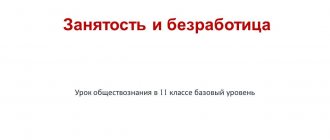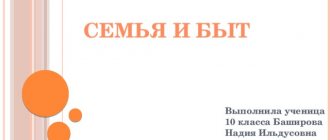Social structure of society 10th grade. Social science. - presentation
Social structure of society 10th grade. Social science.
Social structure The internal structure of society. Social roles Social groups
Social status The social position of a person in society, which depends on: -profession, -economic status, -political opportunities, -demographic properties of a person. Status indicates a person's place in society. Target audience of Radio Monte Carlo
Types of social statuses PrescribedPrescribed - given to a person by society. AchievableAchievable - acquired by a person through his own efforts over a certain period of time. At the end of the twentieth century, most social statuses are attainable.
Social role A way of human behavior. The status includes several roles. Each role is assigned a range of rights and responsibilities, which depend on social norms.
Social group Any set of people identified according to such criteria as: -gender, -age, -nationality, -race, -profession, -education, -place of residence, etc. The number of groups on earth is 2 times greater than the number of people.
Social inequality Different social groups occupy different positions in society. Social differentiation Social differentiation is the division of society into social groups occupying different positions in society. This position is determined by unequal rights and privileges, responsibilities and duties, property and income, and attitude to power.
Social equality social equality different points of view The existence of inequality does not remove the question of social equality. There are different points of view: 1. Marxism believes that inequality is associated with private property. 2. Social equality is a utopia. 3. In modern society, social equality is equality before the law and equality of opportunity.
Social stratification Interconnected social groups form the social structure of society. What is the main element of this structure? Class approach Marxist theory It is based on the division of society into classes. The criterion is property. Social stratification Division of society into strata (layers). Criteria: income, prestige of the profession, education, age, place of residence, amount of power, etc.
Social structure Rich Middle class Poor Rich Middle class Poor Lumpens Lumpens are people who have sunk to the “bottom” of social life: tramps, homeless people, beggars. Marginals Marginals are people who occupy an intermediate position between stable social strata: immigrants, the unemployed, migrants, and the disabled.
Social mobility Moving from one social group to another. Types of mobility: Vertical mobility Vertical mobility is movement from one rung of the social ladder to another. Horizontal mobilityHorizontal mobility is the transition of a person to a group that is at the same level as the previous one. Types of mobility: Vertical mobility Vertical mobility is movement from one rung of the social ladder to another. Horizontal mobilityHorizontal mobility is the transition of a person to a group that is at the same level as the previous one. Transition from one company to another, from one family to another, from one citizenship to another. Upward vertical mobility Upward vertical mobility: career, education, increase in income. Downward vertical mobility Downward vertical mobility: ruin, demotion.
Social elevators Paths along which people move from one social group to another. army education profession marriage property church
Social mobility closed society Changes in status in patriarchal, feudal societies are extremely limited (classes, castes) - closed society. open society In modern society, restrictions on social movements have been lifted - an open society.
Social interests Interests of people related to the position of a social group in society and a person in it. Social interests are embodied in activity: its direction, nature, results. They are aimed at preserving relationships in the group on which the distribution of benefits depends. Social groups defend their interests and influence politics: marches, demonstrations, elections, the creation of parties.
Homework Read §14, learn the concepts. P. 161 complete tasks 1-4 in writing in your notebook.
Presentation "Social Groups"
Social groups
Concept of social group
A social group
is an association of people who have a common significant social characteristic based on their participation in some activity connected by a system of relations that are regulated by formal or informal social institutions.
Family, school class, friends and professional team are the most significant social groups for an individual. It is they, due to their stability, that influence the nature of social development and social adaptation of the subject.
Main characteristics of a social group:
1. The presence of integral psychological characteristics
, such as public opinion, psychological climate, group norms, group interests, and so on, which are formed with the emergence and development of the group .
A specific person cannot have an integral characteristic of a group, which is determined by a special psychological field that arises during the interaction of individuals. Social control, which exists in each group, influences the formation and development of integral psychological characteristics.
2. The existence of the basic parameters of the group as a single whole.
A social group has the following parameters: composition and structure, group processes, group norms and sanctions.
Group composition
is a set of characteristics of group members that are important from the point of view of its analysis as a whole. For example, the size of the group, its age or gender composition, nationality or social status of group members.
The structure of the group
is considered from the point of view of the functions that individual members of the group perform, as well as from the point of view of interpersonal relationships in it.
Group processes include dynamic, that is, changing indicators of the group as a social process of relations. Particular importance is attached to the psychological and organizational processes of cohesion (leadership and management), the level of development of the group as a social unity (stage of team development), the process of group pressure (conformism), processes of changing relationships, and so on.
3. The ability of individuals to take coordinated action.
This feature is key, since it is consent that provides the necessary community, unity of actions aimed at achieving the goal.
The degree of coordination of actions depends on the level of development of the group, the social situation, the activities of the leader or
leader.
The ability to act independently of the group and influence its decisions characterizes the social strength of the individual.
4. The action of group pressure
, encouraging a person to behave in a certain way and in accordance with the expectations of others.
The individual result of such pressure is conformity as a quality of a person in a normative or non-normative version.
5. For teachers, the most important feature of a group is
the establishment of certain relationships between its members. All social relationships are of two types: conventional (formal) and interpersonal (informal). These two types of relationships are combined in any social group.
Typology of social groups
The main criteria for identifying such typologies can be: the number of people in the group, social status, level of development, and so on.
According to social status, groups are divided into
formal and informal , according to the directness of relationships - into real and nominal , according to significance - into reference and membership groups .
The most commonly used typologies are distinguished:
by the number of people and by level of development .
These two criteria are significant for the pedagogical organizational activities of the teacher.
Based on the number of people
, large groups, small groups and microgroups are distinguished.
The composition
of microgroups includes three or two people. The main connecting factors of these groups are feelings of friendship, love, sympathy, and a common cause.
A small group
is one whose members know each other personally. One of the leading factors that unites a group is joint activities and a common goal.
According to the level of development, groups are distinguished as unorganized or weakly organized, with a low cohesion index:
associations , diffuse groups , and groups of a high level of development - collectives .
In
an association, there is no unifying joint activity that requires appropriate organization, however, there is a certain level of cohesion determined by the joint communication of individuals.
In
a diffuse group there is no cohesion, no organization, and no joint activity. Groups are often in a state of diffusion in the first period of their existence.
Groups are also considered from the point of view of their attitude towards society: positive -
prosocial , or negative - asocial . Any team is a well-organized prosocial group.
A well-organized asocial group is called
a corporation. A corporation is usually characterized by isolation, brutal centralization and authoritarian management, opposing its narrow interests to public ones.
A social group acts as a dynamic formation: it functions in time and space and is determined by the interaction of two trends -
integration and differentiation .
Integration
is aimed at counteracting conflicts and situations that threaten the existence of the group as a whole.
Differentiation
is aimed at specializing the relationships of group members based on the difference in their roles.
The formation, functioning and development of a group is contradictory. A consistent change in a group is possible both from a low to a higher level of development, and vice versa - from a high level of development to a simple association.
Completed the presentation
Vershuta Nadezhda
Repetition, generalization, systematization of knowledge (learning activity itself).
Working on the presentation:
Slide No. 4 is shown: “Blitz survey”: Teacher: “I name the concept, and you give the definition. Each group has its own secretary, who fills out the Table of Success for each student in the group.”
Teacher: You know quite a lot on this topic, it makes me happy. All the concepts to which you have given definitions act as tested elements within the Unified State Exam. So, let's continue the repetition.
Teacher: Every person is a member of several social groups
Presentation:
Slide No. 5 is shown: “Logical chain”
Teacher: “Any social group unites people with similar statuses and roles. Groups are large and small. Members of a small group, unlike a large one, have direct personal contacts. For example, classes, estates, castes are large groups. Family, school class, circle of friends - small group. A social community in the broad sense of the word includes not only groups identified on the basis of social characteristics (income level, level of education, place in the system of power relations), but also aggregates of people united by geopolitical, cultural-historical, territorial, and demographic characteristics. For example, nationalities, nations, ethnic groups are social communities.
Assignment: Give other examples of the diversity of social groups and communities.
Teacher: The totality of interacting and interconnected social groups and communities forms the social structure of society.
Presentation:
Slide No. 6 is shown: “Which scheme, in your opinion, is more correct? Why?
Teacher: Social groups and strata occupy different social positions, in other words, they have an unequal amount of material wealth and power, rights and responsibilities, privileges and prestige. This expresses the social stratification of society, leading to social inequality. In the most schematic form, social inequality, social stratification is expressed in the division of society into lower (poor), middle and upper strata (rich). Which group will answer the task faster? The secretaries record the points they earn in the Success table.



